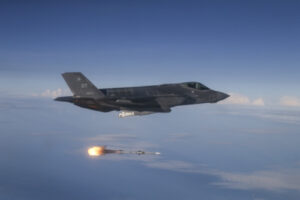Defense Daily International
-
DDI for Fri. March 30, 2018
- Poland And U.S. Sign $4.75 Billion Agreement For Patriot Missile Defenses
- Lockheed Martin Unveils South Korea’s First F-35
- MBDA Wins $566 Million U.K. Contract To Extend Brimstone Missile Life Past 2030
- UK Eyes Cutting F-35 Sustainment Costs
- Boeing HorizonX Invests In Australian Satellite Communications Firm
-
 Uncategorized
UncategorizedBoeing HorizonX Invests In Australian Satellite Communications Firm
Boeing [BA] on March 26 said its HorizonX ventures arm has made an investment in a small Australian company focused on nanosatellite communications for remote areas. Boeing doesn’t disclose the specifics […]
-
 Uncategorized
UncategorizedMBDA Wins $566 Million U.K. Contract To Extend Brimstone Missile Life Past 2030
The United Kingdom awarded MBDA a $566 million contract to extend the service life of the Brimstone air-to-surface missile through the capability sustainment program (CSP), the company said March 27. Through the […]
-
 Uncategorized
UncategorizedUK Eyes Cutting F-35 Sustainment Costs
The United Kingdom is looking for ways to drive down the cost of operating and sustaining its F-35 Joint Strike Fighter fleet now that the program is transitioning from its […]
-
 Uncategorized
UncategorizedLockheed Martin Unveils South Korea’s First F-35
The first of 40 F-35A Lightning IIs that are being built for South Korea made its public debut March 28 during a rollout ceremony at Lockheed Martin’s [LMT] fighter jet plant in Fort […]
-
 Uncategorized
UncategorizedPoland And U.S. Sign $4.75 Billion Agreement For Patriot Missile Defenses
Poland signed a Letter of Offer and Acceptance (LOA) to buy Raytheon’s [RTN] Patriot air and missile defense system, interceptors, and a battle management system for upward of $4.75 billion during […]
-
 Uncategorized
UncategorizedState Department Approves Deals With Saudi Arabia For Missiles, Vehicle Logistics And Helicopter Support
The State Department has approved several possible deals with Saudi Arabia, including $670 million for TOW 2B (BGM-71F-Series) missiles, $300 million in logistics support for their Land Forces Ordnance Corps […]
-
 Uncategorized
UncategorizedGlobal Industry Partnerships Critical To Thwarting Future Cyber Threats
Global partnerships led by U.S. and overseas private sector partners will be critical to addressing cyber threats aimed at exploiting known vulnerabilities in critical infrastructure networks, according to U.S. and […]
-
 Uncategorized
UncategorizedHewson Lauds Trump’s Actions To Protect U.S. Companies Against China’s Theft Of Intellectual Property
Lockheed Martin [LMT] Chief Marillyn Hewson on March 22 praised President Trump’s new executive actions aimed at punishing China for unfair trade practices, in particular the theft of intellectual property. “I […]
